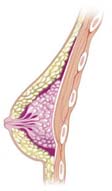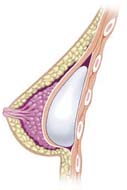   |
| FDA
Home Page | CDRH Home Page | Search
| CDRH
A-Z Index | Contact CDRH
|

When choosing a surgeon who is experienced with breast implantation, we recommend that you find out the answers to the following questions:
When you have answers to these questions, you will have a better idea of the technical qualifications of your surgeon.
You should consider the following when you and your surgeon are discussing implant options.
Implant Status – Whether or not an implant is PMA-approved or investigational (not PMA-approved) should be something you consider (see the Status/Availability section for details). An implant that is investigational means you will need to be part of a clinical study to get these implants. In addition, the surgeon of your choice may work with only specific breast implants.
Shape and Size - Depending on the desired shape and size you wish to achieve, you and your surgeon may choose a round or contoured implant shape of appropriate size (volume). You should be aware that contoured implants that are placed submuscular (under the pectoralis major muscle) may assume a round shape after implantation. Your surgeon will also evaluate your existing tissue to determine if you have enough to cover the breast implant.
Implant Surface - Textured surface implants were designed to reduce the chance of capsular contracture. Some studies with small numbers of women suggest that surface texturing reduces the chance of severe capsular contracture. However, other studies of a large number of women with saline-filled implants show no difference in the likelihood of developing capsular contracture with textured implants when compared to smooth-surfaced implants.
Implant Palpability/Visibility - The following may cause implants to be more palpable (more easily felt) or more visible: textured implants; larger implants; subglandular placement; and smaller amount of skin/tissue available to cover the implant.
Choosing the Surgical Incision Site
You should discuss the pros and cons for each incision site you are considering with your surgeon. Your surgeon may recommend an incision site for you depending on whether you will be having augmentation or reconstruction.
Augmentation Incision Sites – The three common incision sites are under the arm (transaxillary), around the nipple (periareolar), or within the breast fold (inframammary). The sketch below shows each of these incisions sites.65

The umbilical/endoscopic incision site is not recommended by companies.
Reconstruction Incision Sites - Most implants in breast
reconstruction use the mastectomy scar either immediately during the mastectomy
procedure or after tissue expansion.
Choosing the Type of Implant Placement
The breast implant can be placed either submuscularly or subglandularly. You should discuss with your surgeon the pros and cons of the implant placement selected for you.
| Submuscular Placement Possible Results |
Subglandular Placement Possible Results |
|---|---|
| Surgery may be longer | Surgery may be shorter |
| Recovery may be longer | Recovery may be shorter |
| Reoperation may be more difficult | May provide easier access for reoperation |
| Less palpable implants | More palpable implants |
| Easier imaging during mammography exam | More difficult imaging during mammography exam |
The sketches below show the differences between subglandular and submuscular placement of your implant compared to a breast before augmentation. The sketches below show the differences between subglandular and submuscular placement of your implant compared to a breast before augmentation.66
 |
 |
 |
|
Breast before augmentation |
Breast after subglandular augmentation |
Breast after submuscular augmentation |
General Description of Breast Implant Surgery
Breast implant surgery can be performed on an outpatient (not in the hospital) basis or in a hospital. It can be done under local anesthesia (only the breast area is numbed) or under general anesthesia (put to sleep or not aware of having surgery).
Breast implant surgery can last from one to several hours depending on your particular case (your condition, implant choice, incision site, implant placement, etc.).
If the surgery is done in a hospital, the length of the hospital stay will vary according to the type of surgery, the development of any postoperative (after surgery) complications, and your general health. The length of the hospital stay may also depend on the type of coverage your insurance provides.
Before surgery, your doctor should discuss with you the extent of surgery, the estimated time it will take, and the choice of treatment for pain and nausea.
Your doctor should describe the usual postoperative recovery process, the possible complications that can arise, and the expected recovery period. Following the operation, as with any surgery, you can expect some pain, swelling, bruising, and tenderness. These complications may last for a month or longer, but they should disappear with time. In addition, scarring is a natural outcome of surgery. Ask your doctor to describe the location, size, and appearance of the scars you can expect to have. For most women, scars will fade over time to thin lines, although the darker your skin, the more prominent the scars are likely to be.
Your doctor may prescribe medications for pain and nausea. Some women may experience bleeding and some may experience fever, warmth, or redness of the breast, or other symptoms of infection. You should report these symptoms immediately to your doctor. Your doctor should tell you about wound healing and how to care for your wound. Drains may be used for a few days.
You may need a post-operative bra, compression bandage, or jog bra for extra support and positioning while you heal. At your doctor’s recommendation, you will most likely be able to return to work within a few days, although you should avoid any strenuous activities that could raise your pulse and blood pressure for at least a couple of weeks. Your doctor may also recommend breast massage exercises.
Ask your doctor about a schedule of follow-up examinations, limits on your activities, precautions you should take, and when you can return to your normal routine, including exercising. (If you are enrolled in a clinical study, your doctor should give you a schedule for follow-up examinations set by the study plan.)
Choices in Reconstructive Procedures
The type of breast reconstruction procedures available to you depends on your medical situation, breast shape and size, general health, lifestyle, and goals. You can have your breast reconstructed with a breast implant, a tissue flap (your own tissues), or a combination of the two. If you have breast reconstruction, with or without breast implants, you will probably undergo several reoperations to improve symmetry and appearance.
For example, after your breast has healed from the original implant surgery, you may want to build a new nipple and darken the areola (skin around the nipple). This procedure can usually be performed on an outpatient basis. Ask your doctor to explain the various ways this can be done, such as using a skin graft from the opposite breast or by tattooing the area. Ask your doctor about the pros and cons of each implant technique. If you decide to have reconstruction for one breast, your doctor may suggest surgery on the other breast to achieve a similar appearance.
The following issues should be considered for women with breast cancer:
Breast Reconstruction with Breast Implants
The following information applies to reconstruction following mastectomy. However, similar considerations apply to reconstruction for breast trauma or congenital defects.
Your doctor will decide whether your health and medical condition makes you an appropriate candidate for breast reconstruction with breast implants. Women with larger breasts may require reconstruction with a combination of a tissue flap and an implant.
Your doctor may recommend a breast implant, reduction mammoplasty (breast reduction), or a mastopexy (breast lift), of your opposite, uninvolved breast to improve symmetry with your reconstructed breast. Reduction mammoplasty involves removal of breast tissue and skin. Mastopexy involves removing a strip of skin from under the breast or around the nipple and using it to lift and tighten the skin over the breast. If it is important to you not to alter the unaffected breast, you should discuss this with your doctor because it may affect the breast reconstruction procedures considered for your case.
The breast reconstruction process may begin at the time of your mastectomy (immediate reconstruction) or weeks to years afterwards (delayed reconstruction).
Immediate reconstruction is one-stage or two-stage reconstruction.
Delayed reconstruction is a two-stage reconstruction starting with a breast tissue expander placed months or years later, which is then replaced several months later with a breast implant. This is considered delayed reconstruction because the tissue expander is placed after the mastectomy site has healed.
It is important to know that the one and two-stage references do not mean the number of surgeries involved. You should expect that any type of breast reconstruction will take several steps to complete. It could take months to years before your reconstruction is complete.
Two potential advantages to immediate reconstruction are that your breast reconstruction starts at the time of your mastectomy and that you may save money when you combine the mastectomy with the first stage of the reconstruction. However, with immediate reconstruction, there may be a higher risk of complications, such as rupture/deflation, as well as longer initial operation and healing times.
A potential advantage to delayed reconstruction is that you can delay your reconstruction decision and surgery until other treatments, such as radiation therapy and chemotherapy, are completed. Delayed reconstruction may be advisable if your surgeon anticipates healing problems with your mastectomy, or if you just need more time to consider your options.
There are medical, financial, and emotional considerations to choosing immediate versus delayed reconstruction. You should discuss the pros and cons with the options available in your individual case with your surgeon, plastic surgeon, and oncologist.
Breast Reconstruction with Tissue Flaps
The breast can be reconstructed by surgically moving a section of skin, fat, muscle, and blood vessels from one area of your body to another. The tissue may be taken from such areas as your lower abdominal area, upper back, or buttocks.
The most common types of tissue flaps are:
Flap surgery has the advantage of using your own tissue to construct a new breast. However, it is important for you to be aware that flap surgery, particularly TRAM flap surgery, is a major operation and more extensive than your mastectomy operation or breast implant surgery. It requires good general health and strong emotional motivation. If you are very overweight, smoke cigarettes, have had previous surgery at the flap site, or have any circulatory problems, you may not be a good candidate for a tissue flap procedure. Also, if you are very thin, you may not have enough tissue at the flap site to construct a breast mound.
Tissue flaps, in general, can be moved to the reconstruction site by one of two methods. The first method is when the flap is left attached to the muscle and blood vessels and tunneled under the skin to the reconstruction site. The second method is when the flap is completely removed and then transferred to the reconstruction site and reattached by microsurgery. More specifically, the TRAM flap can be done by either of these two methods while the Latissimus Dorsi flap procedure involves only the first method. In addition, for TRAM flap surgery, your surgeon may also need to build you a new belly button after the lower abdominal area is reshaped.
Flap surgery requires a hospital stay of several days and generally a longer recovery time than breast implant reconstruction. While you can resume normal daily activity after several weeks, some women report that it takes up to one year to resume a normal lifestyle.
Flap surgery also creates scars at the site where the flap was taken and possibly additional scars on the reconstructed breast. You may also have some temporary or permanent decreased muscle strength at the flap site.
As a special note regarding the TRAM flap procedure, if you are considering
pregnancy after your reconstruction, you should discuss with your surgeon how
this procedure may affect your abdominal muscle strength. In addition, although
abdominal tissue feels like breast tissue to the touch, the nerves are cut during
the surgery, so there may be little feeling or sensitivity in your breast. Also,
you should know that a surgeon can take tissue from your abdomen only once.
If you later need a mastectomy of your second breast and want to have a tissue
flap procedure, then the tissue will have to come from another site, such as
your back.
Questions to Ask Your Surgeon about Breast Augmentation
The following list of questions may help you to remind you of topics to discuss with your surgeon. You may have additional questions as well.
Questions to Ask Your Surgeon about Breast Reconstruction
The following list of questions may help to remind you of topics to discuss with your surgeon. You may have additional questions as well.
65Sketch from Inamed patient
labeling at FDA’s website at http://www.fda.gov/cdrh/breastimplants/.
66Sketch from Inamed patient labeling at FDA’s website at http://www.fda.gov/cdrh/breastimplants/.
Return to Table of Contents
Updated June 8, 2004
![]()
CDRH Home Page | CDRH A-Z Index | Contact CDRH | Accessibility | Disclaimer
FDA Home Page | Search FDA Site | FDA A-Z Index | Contact FDA | HHS Home Page
Center for Devices and Radiological Health / CDRH